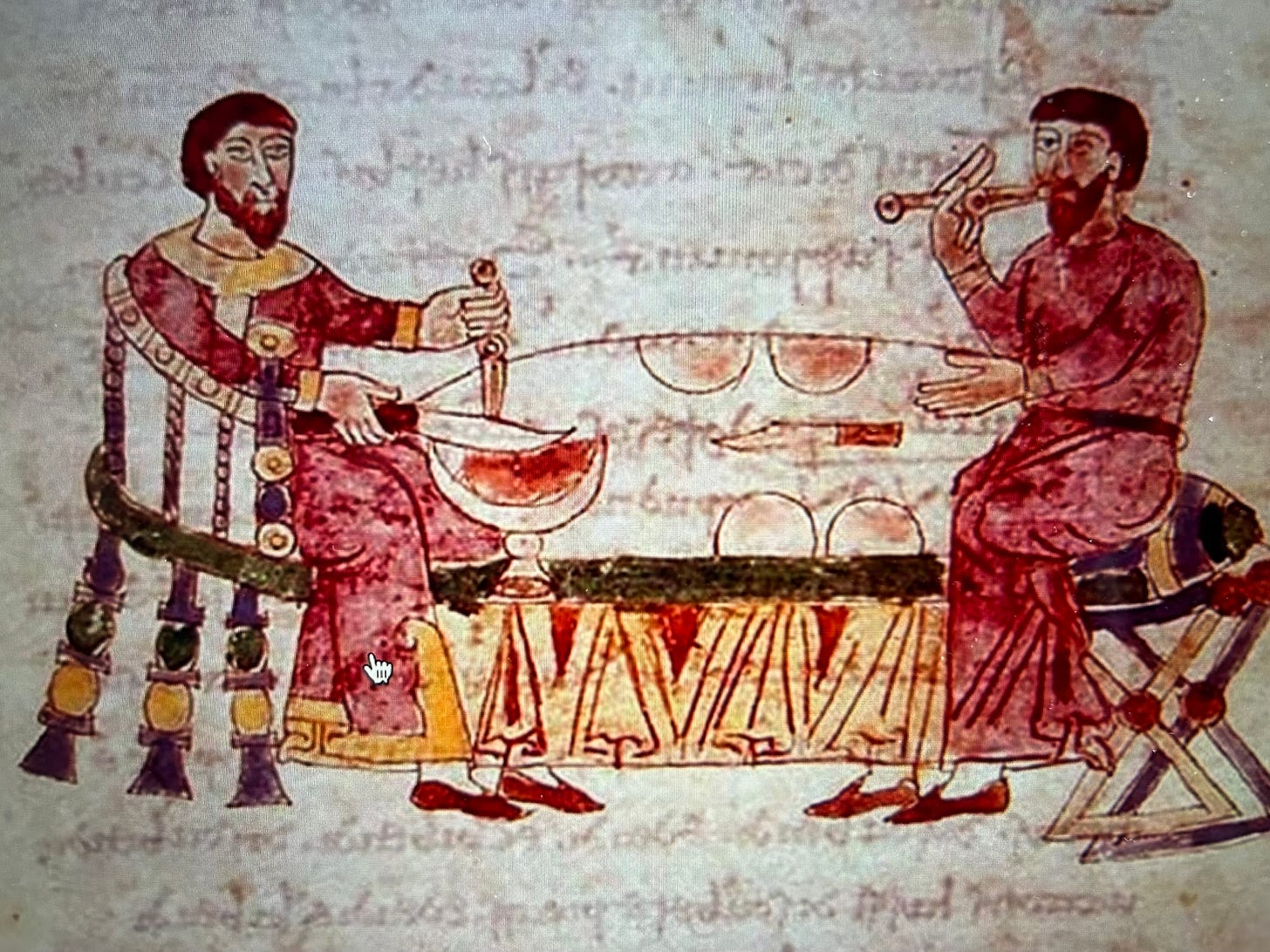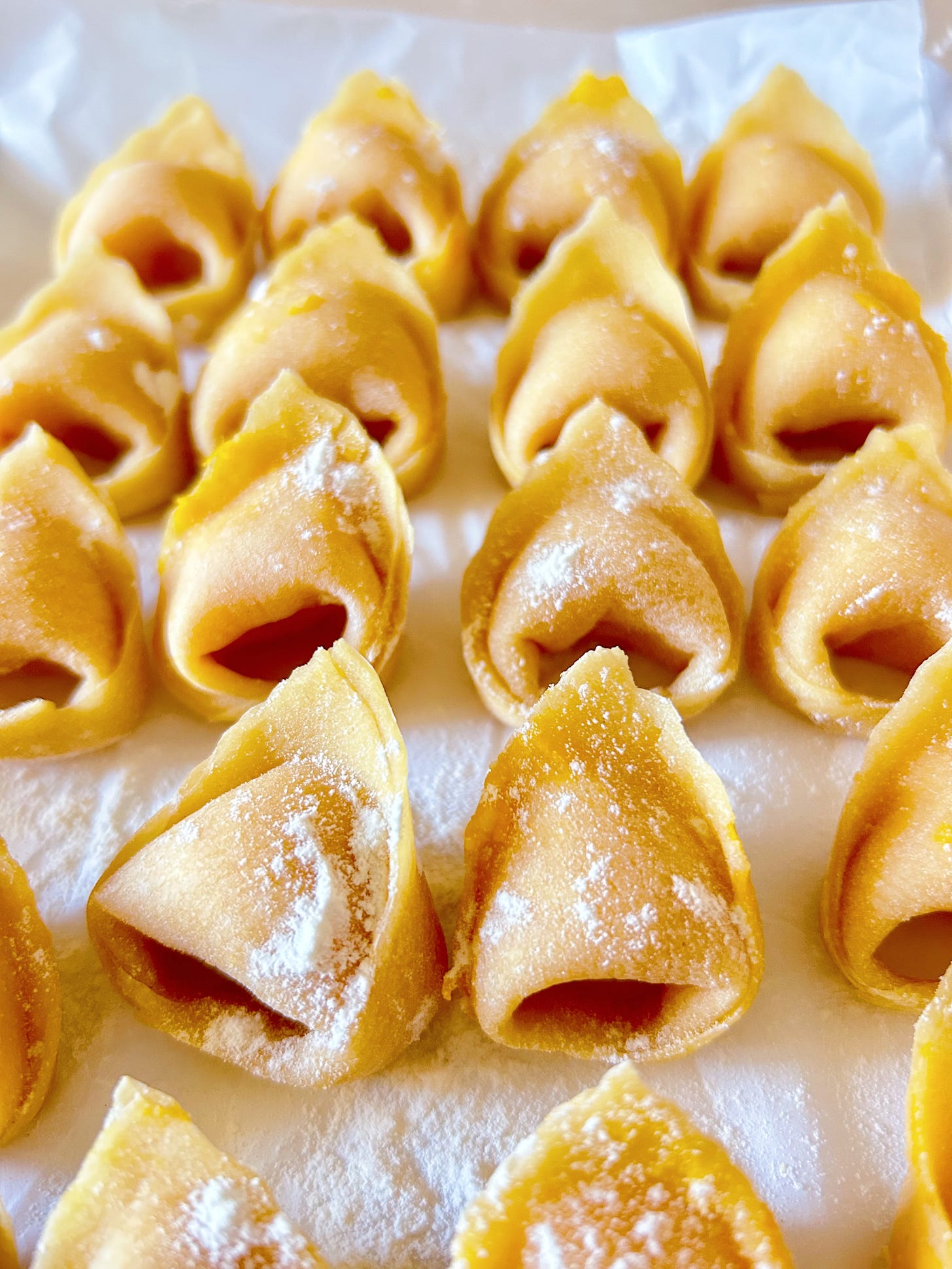History of Italian Pasta (part 2)
plus, two recipes from Emilia-Romagna deeply connected with History
Where is Dante's fame ahead of the glory of spaghetti?
(G. Prezzolini, Italian intellectual and teacher of Italian literature at Columbia University)
Thank you for reading and sharing.
I’ll be eternally grateful for your support.
Grazie, Monica
Let’s keep the conversation going.
Write to me at tortellinico@gmail or follow me on Instagram.

As I told you, Food Notes from Bologna is the new name of my newsletter, and I hope you like it.
Shall we get started?
A brief recap of the previous newsletter about the History of Italian pasta
The origins of the pasta we know, produce, and eat in Italy lead back to Mesopotamia.
That culture then passed to Magna Graecia and, from there, to the Roman Empire.
Pasta starts as a derivative of bread. It is a functional ingredient in other preparations and is not yet a food category with a definite identity.
Làganon (Magna Graecia) and lagana (from old Roman times) designate a preparation similar to fresh pasta that, with few documented exceptions, is prepared fried, in the pan, or baked.
The Arabs spread the culture of dry pasta to the West.
By the 12th century, the production and marketing of this product had already begun in Italy.
Macharoni, the story of a name
In Arabic treatises on cooking and dietetics, the term itriyya, analogous to the Jewish itrium, means pasta. The two words are linguistically similar to the old Greek tria but not in meaning (in ancient Greek, under the name tria find preparations more similar to bread and crêpes).
The Arab term for long-shape dry pasta in medieval Latin, TRIA, is still used in South Italy (ciceri and tria = chickpeas and pasta).
The word macharoni has been in use since the 11th century, and many linguistic studies propose that the Arabic muqarrada, a mixture of sugar and dried fruit cut into small portions, is the etymology of the term, which in Italy comes out of the sphere of patisserie unlike in France (macaron).
Returning to Italy, the word macharoni indicates semolina or flour large gnocchi (dumplings) that are then thinned, stretched, and perforated to aid drying.
Pies (torte) become tortelli and tortellini
The 3rd novella of the 8th day of the Decameron tells the story of Calandrino in the land of Bengodi. From the top of a mountain of grated Parmesan cheese, macaroni, and ravioli, boiled in capon broth, slide into a lake of melted butter.
The utopia described by Giovanni Boccaccio in the second half of the 14th century gives us significant information about pasta:
it cooks in broth,
it is seasoned with grated Parmesan cheese and butter.
Early Italian cookbooks dating from the 14th and 15th centuries, usually written by court cooks, allot just a recipe here and there to dried pasta. In the early part of the Middle Ages, preserved products were still food for the lower classes. In contrast, there is a more consistent number of recipes based on fresh pasta dough.
That, I remember you, is still a side or used to create stuffed pies, complex gastronomic masterpieces highly prized at Renaissance courts.
Short note:
the tradition of stuffed pasta, ancient and probably of Turkish-Mongolian origin, is -again- part of the knowledge spread to the West by the Arabs.
Italian food historian Massimo Montanari notes that one of the most significant innovations of the medieval era is the result of the union of two different traditions: lagana and medieval pies.
The lagana, made of fresh pasta, which contains the filling of medieval pies (TORTE), becomes smaller, and from those little pies come tortelli and tortellini.
Little by little, the description of procedures in the cookbooks for making different pasta shapes becomes more precise and is almost always accompanied by geographical attribution.
Maestro Martino, the Pope's cook during the second half of the 1400s, describes Sicilian macharoni that are one palm-hand long and pierced with a spagho (for the first time the term is used although about the tool and not the pasta format. We have to wait until the second half of the 19th century for the word spaghetti); Romanesque macharoni, made from the pasta sheet, which resemble tagliatelle or fettuccine.
The importance of medicine in the history of pasta
In essays from near the end of the Middle Ages (c. mid-15th century), medical scientists first file the different shapes under a collective name that aggregates them all together.
In this way, pasta assumes its identity, leaving behind centuries of uncertainty and ambiguity.
Again, doctors provide method directions for cooking dry pasta, and later fresh, in a liquid.
It is interesting to remember that medicine and cooking have been closely connected since ancient times and that the assumption of opposites that must be balanced by finding a point of equilibrium was applied to the medical science of the time.
What does this digression have to do with pasta?
The "first field of application of this rule was cooking, suggesting pairings and cooking practices, for instance, roasting moist products and boiling dry ingredients" (Montanari).
So, if pasta becomes moist after cooking, the cook has to re-correct it with the right condiment.
Doctors of Arab-Islamic culture, then European ones, suggest combining rehydrated pasta with dry elements such as spices, which, it must be said, are expensive.
And the same principle also supports pairing it with aged cheese.
We can assert that that food combination helps the pasta to become a new food category.
Pasta meets the cow shed
Between the 12th and 13th centuries in Emilia-Romagna and Lombardy, Parmigiano and its brothers were born.
It happens thanks to the spread of cattle breeding, which, especially in Emilia, takes away space from the traditional presence of pigs.
The Cistercian monks, major landowners, are the first to experiment with new agricultural techniques that add man's contribution to the conditions created by climate and land. This is then the idea behind the concept of terroir developed by the French culture.
They introduce cow's milk cheeses to the market alongside the sheep's milk ones already existing.
And since the success of an ingredient depends on its ability to become significant in the gastronomic system through its prowess in relating to others, the new cow's milk cheeses paired with pasta work for medicine and taste.
The historical affirmation of pasta and hard cheese from here on precedes together.
Lastly, pasta seasoned with cheese changes the habit of serving and eating it.
In Italy, the use of the fork, or similar objects such as the two-pronged fork in the medieval portrait you can see at the beginning of the newsletter, is very early compared to the rest of Europe.
In fact, the boiled pasta made slippery by the sauce of melted Parmigiano and butter gives a new chance for a more systematic use of the fork.
How many things have happened in a handful of centuries!
In the latter part of the Late Middle Ages, after 1200, pasta reunited many different local traditions.
Pasta becomes a food category recognized by medical and gastronomic science.
Renaissance courts enthusiastically welcome the new stuffed pasta bites that turn pies into tortelli or tortellini.
We can say that historically, medically, and gastronomically, the meeting between pasta and Parmigiano is one of the most fruitful and fortunate ever seen.
The quality of the new Italian cheeses overcomes the traditional mistrust of the upper classes toward a product considered suitable only for poor people. The same thing happens for dried pasta.
During the Renaissance, between 1400 and 1500, pasta is an elite food.
The change happens between 1600 and 1800. Finally, we find pasta recipes in modern cookbooks and in the kitchens of many Italians. Think, even in the kitchens of those who emigrate with the dream of a better life and a pasta dish.
For today, our journey ends here. I hope you enjoyed it.
Two recipes from Emilia-Romagna (and from my blog) deeply connected with history
Of the ancient techniques for cooking pasta, of course, many traces remain.
Today, the most widely used method is boiling. Even when pasta bakes in the oven, before boiling it. But, in some recipes, the ancient method survives.
In Emilia-Romagna, this happens with the sweet version of many fresh kinds of pasta: tortelli or ravioli filled with custard or chestnut and sweet fried tagliatelle.
Sweet, fried Tagliatelle (typical of the Carnival season)
The Recipe
4 servings
Equipment
cutting board
rolling Pin
brush
frying pan
Ingredients
Filling
100 g of brown or caster sugar
grated zest of one organic lemon (if it is small, use the grated zest of 2 lemons)
50 g of maple syrup or honey
20 g of warm water
Pasta dough
200 g of 00 flour
2 medium eggs
1 pinch of salt
30 g of rum or grape or marsala wine
1 l of seed oil for frying
HERE you will find the whole method and that is the link for the video recipe: enjoy!
Pumpkin cappellacci, the tortelli of Ferrara
Fresh pasta stuffed with pumpkin is an ancient dish that mixes sweet and spicy flavors as it was made in medieval times. The recipe, which originated in the countryside, soon conquered the Renaissance courts of the Este family of Ferrara and the Gonzaga family of Montava.
Historically, the Ferrara version is called cappellacci and differs from other pumpkin tortelli in the filling ingredients. Those from Ferrara include only pumpkin, nutmeg, and grated Parmigiano or Grana cheese.
The Recipe.
4 servings
Ingredients
Filling
400 g of cooked chestnut pumpkin pulp
100 g of grated Parmigiano
1/2 teaspoon of powdered nutmeg
a pinch of salt
Pasta dough
200 g 00 flour
2 eggs, about 100 g
The whole method is on the blog.
If you enjoyed this newsletter, please click on the little ❤️ below ⬇️ and






Did the D'Medici eat pasta?